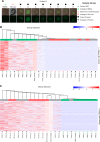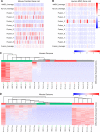Conserved pathway activation following xenogeneic, heterotypic fusion
- PMID: 30807240
- PMCID: PMC9292460
- DOI: 10.1096/fj.201801700R
Conserved pathway activation following xenogeneic, heterotypic fusion
Abstract
Fusion between cells of different organisms (i.e., xenogeneic hybrids) can occur, and for humans this may occur in the course of tissue transplantation, animal handling, and food production. Previous work shows that conferred advantages are rare in xenogeneic hybrids, whereas risks of cellular dysregulation are high. Here, we explore the transcriptome of individual xenogeneic hybrids of human mesenchymal stem cells and murine cardiomyocytes soon after fusion and ask whether the process is stochastic or involves conserved pathway activation. Toward this end, single-cell RNA sequencing was used to analyze the transcriptomes of hybrid cells with respect to the human and mouse genomes. Consistent with previous work, hybrids possessed a unique transcriptome distinct from either fusion partner but were dominated by the cardiomyocyte transcriptome. New in this work is the documentation that a few genes that were latent in both fusion partners were consistently expressed in hybrids. Specifically, human growth hormone 1, murine ribosomal protein S27, and murine ATP synthase H+ transporting, mitochondrial Fo complex subunit C2 were expressed in nearly all hybrids. The consistent activation of latent genes between hybrids suggests conserved signaling mechanisms that either cause or are the consequence of fusion of these 2 cell types and might serve as a target for limiting unwanted xenogeneic fusion in the future.-Yuan, C., Freeman, B. T., McArdle, T. J., Jung, J. P., Ogle, B. M. Conserved pathway activation following xenogeneic, heterotypic fusion.
Keywords: cardiomyocyte; cell fusion; human growth hormone; mesenchymal stem cell; ribosome.
Figures




References
Publication types
MeSH terms
Substances
Grants and funding
LinkOut - more resources
Full Text Sources
Miscellaneous

